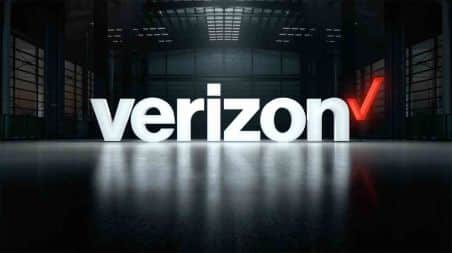The Verizon logo emerged in 2000 when the company was given its current name. Older versions have the company’s old name. The narrative began when Bell Atlantic and South Bell decided to unite in 1996. Their merger also included a mobile company, which is where the name “Verizon” originates from. This article will discuss the history and timeline of Verizon’s logo.
What is Verizon’s Brand?
Verizon is the name of an American telecommunications firm that offers its consumers services such as mobile phones, cable television, digital media, landline, broadband, and others. It is now the leading mobile phone company in the United States.
Verizon Wireless Logo Definition
What does this Verizon logo mean? It’s the creator’s original neologism. It is made up of the Latin words “Veritas” and “Horizon.” An old logo was typed in italics, and the overall design was inadequate. “Z” was transformed into a massive blazing stroke that faded into black. A large tick at the top was supposed to break the symmetry. Many critics thought the logo was ridiculous and caricatured! And this is especially true when buyers encounter your logo on a frequent basis.
The original Verizon logo is challenging to recreate in other mediums due to its complexity (it contains a modified italic typeface, two colors, a stylized letter “z,” a v-shaped form that sometimes appears above the name and sometimes next to it, and gradations in multiple areas). This inconsistency has grown over time.
Verizon, like the way we use communication, has undergone significant transformation over the past fifteen years. Pentagram produced a drastically simplified new logo for the corporation that represents those changes and positions the organization for the future.
The new design keeps the essence of the former brand’s DNA while realigning the mark with Verizon’s fundamental values: simplicity, dependability, and customer loyalty. The unique letterforms have been dropped in favor of a simple presentation of the firm name in Neue Haas Grotesk, fine-tuned by Christian Schwartz of Commercial Type. The color red, which has long been a prominent component of Verizon’s identity, is used as an accent in a brighter, cleaner shade. Finally, the “v” symbol has been replaced by a checkmark, the globally recognized symbol denoting completion. The checkmark, which is placed at the end of the wordmark, serves as a sign-off and validation of the Verizon name.
Verizon Logo Story
The first logo design mirrored the business’s original name, Bell Atlantic Corporation, and was used around the time the company was founded (1984). The logo was made out of two parts: a stylized representation of a bell inside a circle shape and a wordmark next to it.
If not for the peculiar feature in the letter “A” that resembles a wave in the ocean, the text would have had a somewhat boring appearance. The author of the symbol thus brought the “Atlantic” concept to the logo. This could be shown in black or blue on a white background.
In the revised version, the oceanic undertones were amplified. Although the stylized wave vanished from the wordmark, a larger one appeared underneath it. Furthermore, the “Atlantic” theme was emphasized by the use of colors: dark blue and aqua, with white letters and lines reminiscent of sea foam. Instead of the first logo’s aggressive sans-serif style, a basic serif font was utilized. The logotype itself took on a square form.
The Origin of the Verizon Logo
Verizon’s logo is an excellent example of how powerful a simple logo design can be. The original Verizon logo is a red z symbol with an outer look of an electric spark. On the other hand, the current Verizon emblem simply has a red check as a nod to the company’s Latin moniker, “veritas,” which means “trustworthiness.”
Verizon, arguably the world’s most significant telecommunications giant, now has a logo that portrays a forward-thinking, innovative, and confident character. This is far from a coincidence. The Verizon logo was most likely created to portray a sense of innovation and visionary excellence, two essential characteristics that the company appears to actively support.
History
A 13-year antitrust suit brought by the United States Department of Justice against the American Telephone and Telegraph Company, the largest company in the world, was finally settled in January 1982. (AT&T). AT&T kept its manufacturing and research facilities, as well as its long-distance operations, thanks to a consent decree. The company divested itself of 22 local operating companies on January 1, 1984, divided among seven regional holding companies (RHCs).
As a result, Bell Atlantic was formed from AT&T. The new company managed seven telephone subsidiaries and served the northern Atlantic states. AT&T proved to be an immediate and persistent competitor for Bell Atlantic. In February 1984, the company announced that Bell Atlanticom Systems would be created as a systems and equipment subsidiary.
1984 Lawsuit
Bell Atlantic filed a lawsuit in April 1984 in response to the Federal Communications Commission’s (FCC) delay in charging tariffs for customers accessing the local network. Delaying the implementation of the access fee violated the consent decree and required Bell Atlantic and its sibling RHCs to cover some of AT&T’s service costs in the interim, according to Bell Atlantic. To make matters worse, because Bell Atlantic was the least expensive RHC, it was losing the most money. (Access-fee funds were collected first in the FCC system, then distributed to RHCs based on the company’s cost.) Despite the access fee squabble, Bell Atlantic planned to succeed and allocated more than half of its construction budget to network improvements.
Carving Out a Niche
Towards the end of its first year in business, Bell Atlantic made a number of significant acquisitions, including Telecommunications Specialists, Inc. (TSI), a Houston-based interconnect firm; Tri-Continental Leasing Corporation (Tri-Con), a New Jersey-based provider of computer and telecommunications equipment; and the Sorbus Inc. division of MAI, the second-largest U.S. computer service firm.
Bell Atlantic planned to be a full-service company in the increasingly related telecommunications and computer sectors, with the most aggressive diversification of any RHC. Because competing for large customers was unavoidable and because larger customers could potentially set up their own information systems, the company decided to focus on medium-sized customers. Bell Atlantic gave all kinds of services to this group of customers, from information services equipment and data processing to computer maintenance.
Baby Bell Legal Disputes in 1985
The private branch exchange (PBX) market was likely to be the most competitive of all the unregulated businesses that Bell Atlantic was getting into. By the beginning of 1985, IBM and Digital Equipment were maintaining mainframes for their customers, who made up a big part of Bell Atlantic’s new Sorbus customer base. Bell Atlantic, along with its siblings, RHCs, and other companies, realized a year and a half after divestiture that the convergence of telephone hardware and computer data processing was a huge business. Over the next few years, the RHCs kept asking the Department of Justice for business waivers so that they could be more competitive not only in the U.S. telecommunications market but also in the international market.
By the end of 1985, Bell Atlantic’s earnings were $1.1 billion on $9.1 billion in revenue. In comparison to its competitors, Bell Atlantic was the only RHC that was close to turning a profit on its unregulated businesses, which generated $600 million in revenue. While profits at Bell Atlantic’s local phone service remained strong, its Yellow Pages directory publishing division began to compete with Reuben H. Donnelly Corporation, its previous publisher, due to a disagreement.
Read Also: TAYLORMADE LOGO: Meaning, History, Font & All You Need to Know
Meanwhile, the long-distance market has moved dangerously close to the RHC’s home turf. AT&T and other carriers began competing in local areas to carry toll calls. Even though it looks like this is good for residential customers, it isn’t. When outside competitors cut into RHC’s profits, it threatened the profit margin that helped pay for local service. In the mid-December 1985 issue of Telephone Engineer & Management, Bell Atlantic’s chairman and CEO, Thomas Bolger, called the restrictions on RHCs “the most important problem in the telecommunications industry,” and he asked the Justice Department to make a decision before January 1, 1987. If the goal of the breakup was to encourage as much competition as possible in the industry, the RHCs thought that they, as the most likely competitors of industry leaders AT&T and IBM, shouldn’t be stopped from competing fully.
1986-88: More Legal Disputes And Diversification
Bell Atlantic announced a restructuring plan in July 1987, combining basic telephone service and unregulated businesses. The plan also called for all Bell Atlantic telephone company employees to report to their respective presidents.
For Bell Atlantic, the tables quickly turned. In January 1988, the company, along with BellSouth, was accused of misconduct in bids for government contracts. Senator John Glenn of Ohio led the charge that a General Services Administration chief had given the two RHCs confidential price information. Bell Atlantic flatly denied the charges, claiming that the senator’s report was inaccurate.
A New Era in the Late 1980s
A New Era in the Late 1980s Bell Atlantic invested $2.3 billion in network services to upgrade telephone facilities during this time period.
To compete in mobile communications, the company sold a cell phone that was very small and light. At the same time, Bell Atlantic Paging gained 16% more customers. Together with GTE, Bell Atlantic Yellow Pages set up a new company called the Chesapeake Directory Sales Company to reach more customers. Bell Atlantic Systems Integration was founded in 1989 with the goal of researching and developing marketing capabilities in voice and data communications as well as artificial intelligence.
The biggest opportunity for Bell Atlantic came at the end of 1989 when it increased its international activity. Changes in the Soviet Union and Eastern Europe’s economies opened up completely new possibilities for global communications. Since it was sold off, Bell Atlantic had been slowly looking for opportunities abroad. By 1989, it was helping the Dutch national telephone company, PTT Telecom, B.V., and the Spanish national telephone company put in place telephone software systems. A Bell Atlantic German subsidiary was given a contract to install microcomputers and other related equipment at US Army sites in Germany, Belgium, and the UK. With help from consultants in Austria, France, Italy, and Switzerland, Bell Atlantic planned for its European headquarters, Bell Atlantic Europe, S.A., to be in Brussels, Belgium.
1990 Biddings
However, Bell Atlantic continued to face difficulties in the United States. In April 1990, the Chesapeake and Potomac Telephone Company was charged with fraud and told it couldn’t bid on federal contracts. Bell Atlantic retaliated, citing a double standard in which the US Department of Treasury allowed AT&T to win contracts without having all of the required equipment immediately available while prohibiting the Chesapeake and Potomac Telephone Company from doing so. Undaunted by its disagreements with the government, Bell Atlantic had established the world’s largest independent computer maintenance organization by 1990, capable of servicing over 500 different computer brands. Bell Atlantic cemented its position as the leader in the maintenance of both IBM and Digital Equipment Corporation systems with the January 1990 acquisition of Control Data Corporation’s third-party maintenance business.
Bell Atlantic’s international division thrived in the early and mid-1990s. In 1990, the company worked with the Korean Telecommunications Authority on research, marketing, and information exchanges. It also worked with US West to modernize Czechoslovak telecommunications and with Ameritech and two New Zealand companies to buy the Telecom Corporation of New Zealand.
Distinctive Features: 1991-1996
Metro Mobile was the second-largest independent cellular radio telecommunications provider in the United States, and Bell Atlantic bought them out in 1992. This transaction gave Bell Atlantic the most extensive East Coast cellular phone coverage, while a joint venture with NYNEX and GTE to combine their respective cellular networks into one massive national service made headlines from coast to coast.
The year 1995 was crucial for Bell Atlantic’s future. A long-awaited federal court ruling gave the company a sweet victory; a federal judge finally ruled in favor of Baby Bells’ ability to provide long-distance services. Bell Atlantic wasted no time in entering the long-distance market, recruiting customers in Florida, Illinois, North and South Carolina, and Texas in early 1996.
Another significant development in 1996 was the announcement that Bell Atlantic and NYNEX would merge to form the country’s second-largest telephone company. Though few were surprised by the official announcement (rumors had been circulating for months), the deal was both controversial and ironic—once-struggling Baby Bells were now competing with their old parent company. Soon after the merger was announced, a new operating unit called Bell Atlantic Internet Solutions debuted, offering a wide range of both business and residential Internet-based products and services to customers in Washington, D.C., Philadelphia, and New Jersey.
1997-2000: The New Bell Atlantic
The merger of Bell Atlantic and NYNEX was completed in early 1997. The new company’s assets serviced 25% of the overall U.S. market in 13 states and accounted for approximately 140 billion minutes of long-distance traffic; the region not only housed one-third of the Fortune 500’s headquarters, but also the nerve center of the United States government. South of the border, Bell Atlantic continued its string of international coups, this time investing another $50 million in its Mexican venture to gain control of Grupo Iusacell, of which it previously owned 42%.
In early 1998, the new Bell Atlantic served customers in 21 different countries and boasted 39.7 million domestic access lines, 5.4 million wireless customers in the United States alone, and 6.3 million wireless customers around the world. With over 80 million directories distributed annually, the company was also the world’s largest publisher of both print and electronic directories. Following a rocky road in which Bell Atlantic’s local markets were forced open to competitors, the company was seizing new opportunities in the $20 billion long-distance market and the $8 billion video market, as well as continuing to expand globally.
Verizon Logo Font
The old and new fonts are actually two different styles, despite their superficial similarities. The old logo used a modified Helvetica Black typeface, whereas the new typeface is called Neue Haas Grotesk. In fact, it appears to be very similar to Helvetica. Christian Schwartz of the New York and London-based type foundry Commercial Type designed the Neue Haas Grotesk typeface. Schwartz is a partner and the head of the company’s New York office. He is the designer of numerous typefaces that are used by businesses all over the world. Christian Schwartz also collaborated with well-known independent foundries such as Font Bureau and House Industries to create typefaces.
Color
Verizon’s logo has featured the black wordmark with red accents since the year 2000. The red in the current version is reduced to a single checkmark, whereas the previous logo used the color more liberally. The background has been white in both cases. Blue and aqua were part of the palette before, reflecting the company’s maritime roots and the previous name (Bell Atlantic).
Does Verizon Have a New Logo?
Verizon’s new logo debuted in 2015, following the company’s acquisition of AOL. The refined badge retained the previous version’s red and black color palette, but simplified the badge concept and reduced the appearance of red elements. The new version is based on a large black lowercase inscription with a small red tick to the right of the wordmark.
When Did Verizon’s Logo Change?
Verizon’s logo has been changed several times over the years, with the most recent redesign taking place in 2015. When the company was called Bell Atlantic, the first two versions of the badge were created. The Verizon brand’s first logo was introduced in 2000 and was retained for 15 years until the minimalistic black and red wordmark with a small graphical element was created in 2015.
Verizon’s Logo and Color Scheme
The Verizon logo is a multicolor logo with the primary colors black and red. Because black and red are known to represent innovation, they are a popular choice for like-minded brands that want to be associated with this quality.
The Verizon Logo and Typography
The Verizon logo uses a sans-serif typeface to convey its forward-thinking and innovative nature. Another notable aspect of the Verizon logo’s typeface selection is the use of lowercase characters to support the brand’s confident personality.
Verizon wireless logo evolution 2015 has reached a tipping point. The company then dropped its old slogan, “Never Settle.” The time has come for a change, and a new “Better Matters” slogan has been adopted. Changes have also been made to the old “Verizon” logo. It has become far more pleasant and appealing in its new form.
Verizon Wireless Logo Typeface
The typeface used in the logo is Helvetica. The font remained black, bold, and without notches. They removed italics but did not change “Z.” The blazing red tick was shifted to the left. All of the changes resulted in the logo retaining its harmony! It demonstrates that image alignment is a critical feature. Unleveled depictions are unpleasant to the subconscious, which is difficult to notice at first. The truth is that small details are the most important aspect of any logo.
However, some critics have been critical of the new logo variation. They imply that a four-year-old child could easily draw such a logo. And they have a valid point. The logo has improved significantly, but it still lacks quality.
Why Did Verizon Change Its Logo?
Verizon changed its logo to give an opportunity for everyone to gain a better understanding of who Verizon is and where we’re going. After 15 years, the new visual identity marks the start of the next chapter in distinguishing Verizon in the minds of consumers, as well as our revitalized purpose of delivering the promise of the digital world — simply, reliably, and in the way that consumers want.
The new brand identity transforms the best elements of Verizon’s heritage, which are represented by its colors and the Verizon “checkmark,” for a new era. At its most basic, the new logo is a visual statement that honors our history while also reflecting an identity that stands for simplicity, honesty, and joy in a category rife with ambiguity, disclaimers, and frustration. It’s a cleaner, more human design, and the checkmark, the universal symbol for getting things done, expresses Verizon’s dependability in a unique way.
What Is Verizon’s Slogan?
The Verizon slogan “Built Right” is central to what Verizon intends to do in 2023. It means Verizon is committed to advancing technology in order to make the world a better place. It has also been renamed “5G Built Right” as Verizon works to expand and improve its 5G network across the country.
As Verizon competes with other networks, including AT&T and T-Mobile, to roll out 5G technology across the country, its slogan is “5G Built Right.”
Even though other companies are also launching 5G networks, Verizon is using the slogan “5G Built Right” to convince consumers that it is the only company launching the most advanced service. However, Verizon is lagging behind T-Mobile in terms of 5G deployment, and it is not available in nearly as many areas of the United States as its competitors.
What Is the Significance of Verizon’s Slogan?
Verizon describes its networks as “Built Right,” whether they are 4G LTE or the new 5G technology. For example, “Built Right” gives Verizon a sense of superiority and quality, leading you to believe that the 4G LTE and 5G networks have been properly built across the country. “Built Right” is at the heart of Verizon’s mission to build the best telecommunications network possible to help the world advance and move forward.
What Was the Old Verizon Slogan?
Over the years, Verizon has used slogans such as “That’s Powerful” and “Better Matters.” Having said that, the “That’s Powerful” slogan discusses how Verizon’s technology has the potential to change the world. However, Verizon began using “Better Matters” in 2016 when comparing its networks to the competition. Additionally, Verizon has used other slogans over the years, such as “Never Settle” and “We Never Stop Working For You,” to demonstrate how important the customer is to the company.
Why Does Verizon Change Its Slogan?
Verizon must change its slogan from time to time in order to be innovative and create a sense of progress, such as when transitioning from 4G LTE to 5G and changing it to “5G Built Right.” Furthermore, Verizon’s slogan shows that it is adaptable, which is critical when claiming to be the best and most innovative wireless provider in the country.
What Is the Mission Statement of Verizon?
According to its mission statement, Verizon’s main goal is to “bring the promise of the digital world to customers. “We enable their innovative lifestyles.” The mission statement continues, “We do it all through the most reliable network and the most cutting-edge technology.” When you combine the Verizon slogan “Built Right” with the mission statement, you can see that Verizon aims to be the most dependable and trusted network.
What Type of Business is Verizon?
Verizon Communications, Inc. is a holding company that offers a wide variety of telecommunications, information technology, and entertainment services to individuals, corporations, and government entities. The company is split into two divisions, Verizon Consumer Group and Verizon Business Group. The Consumer segment offers wireless and wireline communications services and products to consumers. Local and long-distance voice services, video and data services, corporate networking solutions, security and managed network services, and network access for various Internet of Things (IoT) services and products are all provided by the Business division.
When Was Verizon Founded?
Verizon Communications was formed by the merger of Bell Atlantic and GTE in June 2000. Verizon Wireless was formed by the combination of Vodafone Airtouch, Bell Atlantic, and GTE. The company’s primary areas of operation are Domestic Telecom (16 telephone operating subsidiaries including Internet access), Domestic Wireless (2 wireless subsidiaries), International (including wireless), and Information Services (online and print directories and content).
What Was Verizon’s Original Name?
Verizon was called Atlantic Bell. The Federal Communications Commission approved the US$64.7 billion merger between Bell Atlantic and telephone company GTE in June 2000, nearly two years after the deal was proposed in July 1998.
Who Owns Verizon Now?
Verizon Communications Inc. is the current owner of Verizon. Hans Vestberg, Verizon Communications Inc.’s chairman and CEO (Chief Executive Officer), currently leads the company. Prior to joining Verizon, Hans was the CEO of Ericsson, a Swedish multinational networking and telecommunications equipment and services company. He was Ericsson’s president and CEO for six years.
Hans Vestberg oversaw Verizon’s transformation, making it the world’s first company to implement 5G technology. This included the nationwide rollout of 5G Ultra Wideband technology in 2023.
Conclusion
The Verizon logo has featured a black wordmark with red accents since 2000. The red in the current version is reduced to a single checkmark, whereas the previous logo used the color more liberally. The background has been white in both cases.
Before, the blue and aqua colors matched the old company name (Bell Atlantic) and marine emblem.
References
Related Articles
- DIOR LOGO: The Story Of Christian Dior Iconic Brand Strategy
- TACO BELL LOGO: The True Meaning Behind the Logo!!! (History & Evolution)
- VOICEMAIL APP: Best Apps for Verizon, Android, iPhone, and T-Mobile
- OPEN A FAST FOOD RESTAURANT: How Much Does it Cost? (How to Start)
- VERIZON BLACK FRIDAY AND CYBER MONDAY TECH DEALS IN 2023






